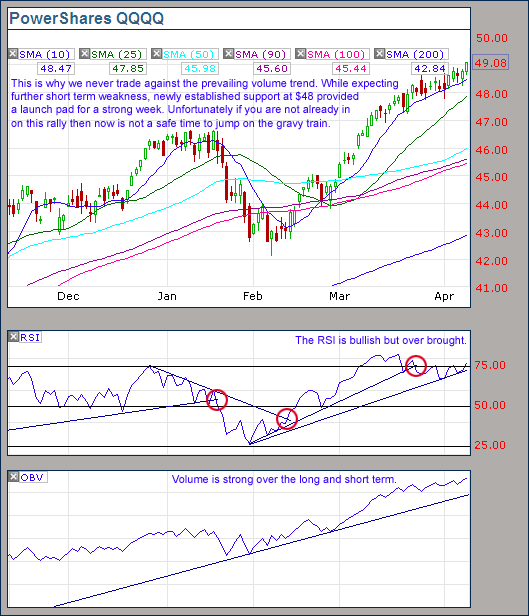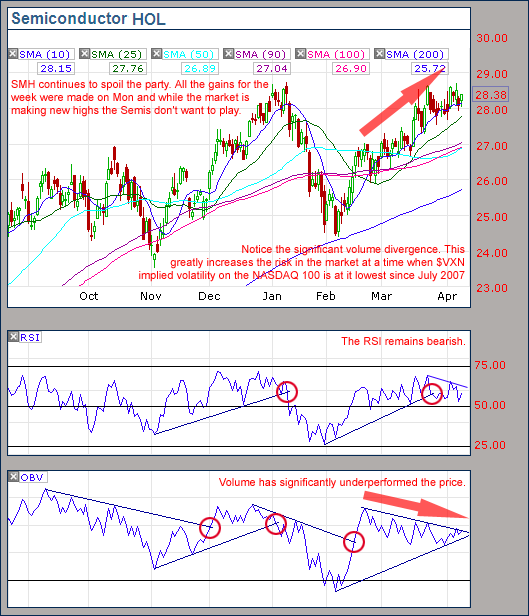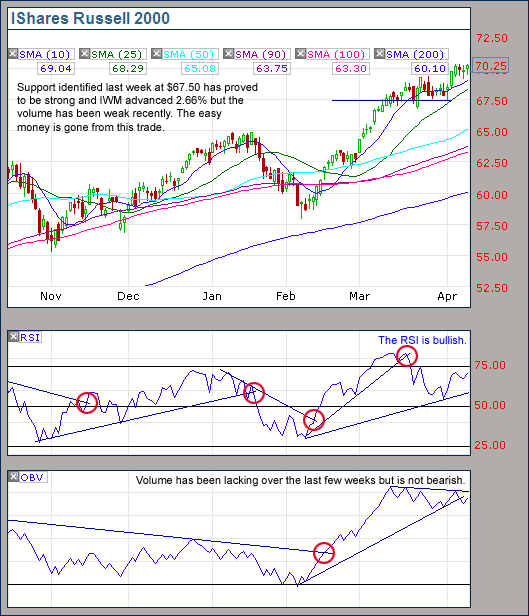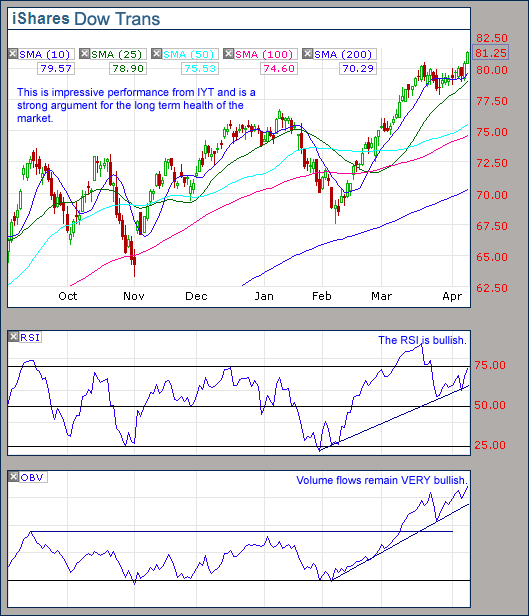April 12, 2010 – 02:45 am ET
Dear Investor,
Thanks for your recent questions and complements. It is nice to hear that you are enjoying our reports. Please spread the word so that the community of readers can grow and also please direct your questions to the comments section so that others can benefit.
In the last report we said “longer term indications remain positive making bearish positions risky”. Since then we have seen a great example of why it is so important to trade in the direction of the prevailing volume trend. For the last few weeks we have been anticipating short term weakness and did see a slow down for a period. But, bit by bit the market has been moving higher and in the last few days it has done so with more vigor.
.
ETF % Change Comparison
.

IWM (Russell 2000 small cap) and IYT (Dow Transportation Index) were the top performers over the last week while SPY and DIA lagged behind. Having the comparatively economically sensitive IWM and IYT leading is good to see.
All of the ETFs we track made new highs this week apart from SMH which continues to be a drag on the market. It finished up 1.65% but all of the gains were achieved on Monday and have dwindled ever since. The broad market in comparison gained strength throughout the week and into Fridays close. The NASDAQ can’t get far without support from the Semiconductors and the market can’t get far without the NASDAQ so continue to keep a close eye on how this develops.
.
What the % Comparison Table Tells Us:
By comparing the performance of the economically sensitive (SMH, QQQQ, IWM, IYT) and the comparatively stable ETFs (SPY and DIA) we can get an indication of the true market direction. The more sensitive areas of the market tend to be the first to initiate a trend change. For example if DIA and SPY sell off heavily while SMH and IWM (Russell 2000 small cap ETF) sell of mildly or continue moving to new highs then this would be very positive and vice versa.
The ‘Average Rank %’ is calculated by subtracting the % change for each ETF from the maximum % change and dividing it by the range for each period. 1-((MAX(% change all ETFs)-ETFs % Change)/(MAX(% change all ETFs)-MIN(% change all ETFs))) The readings for each period are then averaged. This reading is provided because if one ETF was significantly under/out performing the others then a plain high or low rank would not accurately reflect this.
.
![]()
.
A Look at the Charts
.

It looks like SPY has moved into part 2 of the rally that began in mid Feb. This stage of a rally is usually violent and unpredictable so opening new short term positions is too risky.
.

QQQQ has been performing well on strong volume. Enjoy it while it lasts but if you are not already in the market then now is a time for patience.
.

$VXN (CBOE NASDAQ 100 Voltility Index) moved to its lowest level since July 2007 this week. $VXN is a measure of how much ‘time’ is selling for on NASDAQ 100 options and is a function of the risk traders perceive to be present.
When risk levels are perceived to be low the market is more easily spooked and this tends to lead to sharper and more severe reversals. Because $VXN is so low and SMH is under performing on bearish volume it is important to remain cautions.
.

IWM has also had weak volume recently. It will be important for the small caps to continue to perform well if SMH is not going to provide leadership to the broad market.
.

Unlike, SPY, SMH and IWM, the Transports (IYT) have had solid volume flows over the last few weeks. This is an excellent sign for the long term health of the broad market.
.
![]()
.
OM3 Weekly Indicator
.

No signs of weakness here but the average ‘Stong Buy’ signal lasts for 6 weeks so these ones are getting statistically old.
.
How to read the OM3 indicator
The OM3 indicator as with most of our models primarily reads price action and volume. The strong/weak buy/sell signals are self-explanatory. ‘No Signal’ means that the component readings are in conflict and cancel each other out.
The alerts let you know if the cycle is speeding up or slowing down, so when you get at ‘Strong Buy, Bear Alert’ for instance it simply means that the criteria for a strong buy is in place but this weeks cycle reading is weaker (or more bearish) than last weeks reading (the same is true in reverse).
The number of weeks that a signal has been repeated is displayed. Historically a ‘Strong Buy’ signal has lasted for an average of 6 weeks and a maximum of 42 weeks, while a ‘Strong Sell’ has lasted for an average of 4 weeks and a maximum of 16.
This is an indicator not a mechanical trading model. It is useful to assist in analyzing the market but for the best results should be combined with commonsense and support/resistance levels etc.
.
![]()
.
TransDow & NasDow
.

The Dow Transportation index remains dominant over the Dow and has significantly out performed it over that time. The Dow remains dominant over the NASDAQ.
.
What the TransDow Readings tell us:
The TransDow measures dominance between the DJ Transportation Index (DJTI) and the Dow Jones Industrial Average (DJIA). In a strong market the more economically sensitive Transportation Index should be dominant over the DJIA.
Historically the DJTI has been dominant over the Dow 45% of the time. The annualized rate of return from the DJTI during this period was 18.47% with the biggest loss for one trade sitting at -13.27%. The annualized return from the DJIA during the periods it was dominant over the DJTI was just 4.06% and the biggest loss for one trade was -16.13%. A 4% stop-loss is applied to all trades adjusting positions only at the end of the week.
What the NasDow Readings tell us:
The NasDow measures dominance between the NASDAQ and the DJIA. Using the same theory behind the Trans Dow; in a strong market the more economically sensitive NASDAQ should be dominant over the DJIA.
Historically the NASDAQ has been dominant over the DJIA 44% of the time. Taking only the trades when the NASDAQ is above its 40 week moving average the annualized rate of return was 25.47% with the biggest loss for one trade sitting at –8.59%. The annualized rate on the DJIA during the periods it was dominant over the NASDAQ is just 8.88% and the biggest loss for one trade was –12.28%. A 8% stop-loss is applied to all trades adjusting positions only at the end of the week.
.
![]()
.
LTMF 80 & Liquid Q
.

Liquid Q remains in cash while the LTMF 80 trade remains open and is enjoying a nice profit of 15.53%.
.
Historical Stats:
.

.
How The LTMF 80 Works
LTMF stands for Long Term Market Forecaster. It reads volume flows relative to price action and looks for out performance of volume measured on a percentage basis over the prior 12 months. During a sustained rally the readings will reach high levels (near 100%) making it imposable for the volume reading to always outperform price so any reading above 80% will maintain the buy signal. This system has outperformed the market over the last 10 years but performance has been damaged by some nasty losses. It only produces buy signals and only for QQQQ.
How Liquid Q Works
Liquid Q completely ignores price action and instead measures the relative flow of money between a selection of economically sensitive and comparatively stable ares of the market. It looks for times when the smart money is confident and and can be seen by through volume investing heavily is more risky areas due to an expectation of expansion. This system has outperformed the market over the last 10 years and remained in cash through most of the major declines. It only produces buy signals and only for QQQQ. We will provide more performance details on the web site for these systems soon.
.
![]()
.
Summary
.
When there is a lot of momentum behind a mature rally those that have been sitting on the sidelines waiting for a pull back start to jump in as their fear of loss is replaced with a fear of missing out. This 2nd wind can create some impressive gains but usually on light volume and when it ends it tends to end in tears.
So far, several of the ETFs we track have started to float on light volume but QQQQ and IYT both continue to experience strong volume. Long term indications remain healthy but the short term outcome during times like these is very unpredictable.
We turned bullish in our February 22 report so hopefully you have been on the gravy train with us and continue to enjoy the ride (while it lasts). However if you are still sitting on the sidelines then now is not the time to enter the market, there is simply to much uncertainty and risk over the short term.
.
Any disputes, questions, queries, comments or theories are most welcome in the comments section below.
.
Derry
And the Team @ ETF HQ
“Equipping you to win on Wall St so that you can reach your financial goals”
.
P.S If you get value from these newsletters then please spread the word, we grow primarily through word of mouth. Please direct people to ETFHQ.com to subscribe.
P.P.S Become a fan of ETFHQ on Facebook – HERE
.
![]()
.
The Devils Dictionary – H
.
Hedge – A line of closely grouped shrubberies; a clever way of adding correlation and volatility risk to one’s portfolio.
Hedge Fund – A lucrative compensation scheme for professional investors, who get to charge roughly 10 times as much as traditional money managers while generating, in aggregate, similar returns. See Loser’s Game.
House – 1. An abode; an investment. 2. A building constructed on weak financial foundations. Formerly an asset, now a liability. See Delinquencies.